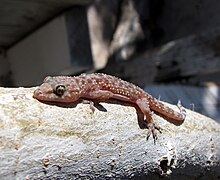| Hemidactylus | |
|---|---|

| |
| Mediterranean house gecko (Hemidactylus turcicus) | |
| Scientific classification | |
| Domain: | Eukaryota |
| Kingdom: | Animalia |
| Phylum: | Chordata |
| Class: | Reptilia |
| Order: | Squamata |
| Family: | Gekkonidae |
| Subfamily: | Gekkoninae |
| Genus: | Hemidactylus Oken, 1817[1] |
| Type species | |
| Gecko tuberculosus Raddi, 1823
| |
| Diversity | |
| 190 species, see text | |
| Synonyms | |
|
In alphabetical order:
| |
Hemidactylus is a genus of the common gecko family, Gekkonidae.[3][4] It has 195[5] described species, newfound ones being described every few years. These geckos are found in all the tropical regions of the world, extending into the subtropical parts of Africa and Europe. They excel in colonizing oceanic islands by rafting on flotsam, and are for example found across most of Polynesia. In some archipelagoes, cryptic species complexes are found.[2] Geckos like to live in and out of houses. They have been introduced to many areas around the world.[citation needed]
This species is closely related to the genus Gehyra, which belongs to the same family in Gekkonidae.
The species are typically known as house geckos, due to their readiness to adapt to and coexist with humans, and can be easily encountered in human habitations.
- ^ "Hemidactylus ". Dahms Tierleben. www.dahmstierleben.de
- ^ a b Lizards of the World (2004). "Hemidactylus". Archived from the original on 28 August 2008. Retrieved 4 April 2009.
- ^ Uetz, Peter, ed. (2021) [1995]. "Higher Taxa in Extant Reptiles". The Reptile Database. Zoological Museum Hamburg. Retrieved 10 December 2022.
- ^ Savage, Melissa (2001). "Hemidactylus ". Animal Diversity Web. University of Michigan Museum of Zoology. Retrieved 10 December 2022.
- ^ Genus Hemidactylus at The Reptile Database www.reptile-database.org. Accessed September 2023.